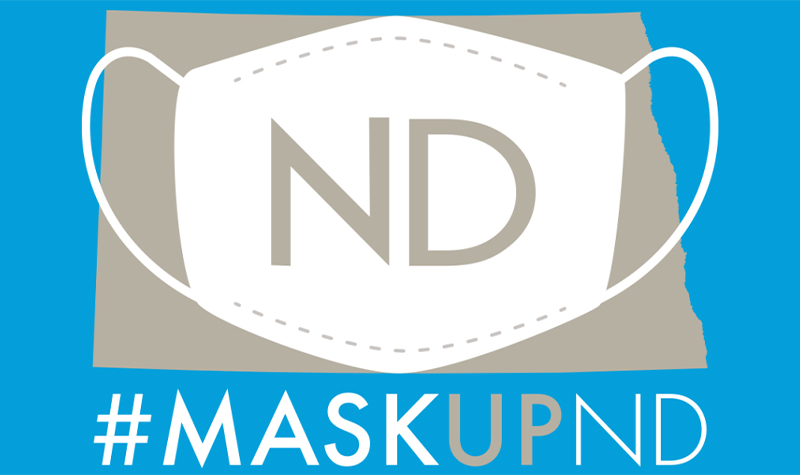Regarding COVID public-health practices, North Dakotans echo Missourians: ‘Show me’
Residents regarded with suspicion the state’s recommendations, but listened and responded to the evidence, a statewide survey by UND found

Skeptical, but willing to be persuaded.
That’s the portrait of North Dakotans that emerges from a statewide survey, conducted by the University of North Dakota and assessing people’s attitudes and behaviors related to the COVID-19 pandemic.
Asked about their top three concerns related to COVID-19, nearly one in four North Dakotans (24 percent) said they did not have any concerns. That’s surprising, given that the survey was conducted last fall, during months in North Dakota that proved to be some of the deadliest of the pandemic.
Likewise, North Dakotans looked at the time to be a tough crowd regarding vaccinations, when they were asked in the survey how likely they’d be to get vaccinated if an Food and Drug Administration (FDA)-approved vaccine became available.
On a scale of 1 to 10, with 1 being “extremely unlikely” and 10 being “extremely likely,” the average rating was only 5.22 statewide.
That was the attitude of population reserving judgment, said Jason Jensen, professor of political science and public administration at UND and executive director of the Institute of Policy and Business Analytics, which conducted the survey.

Inside the numbers
Nevertheless, residents seem to have heeded reassurances about the vaccines’ safety. For evidence, consider that North Dakota ranks No. 1 among states for administering the highest percentage of COVID-19 vaccines it has received, the CDC’s COVID-19 vaccine distribution and administration data tracker reported on April 1.
Moreover, majorities supported the interventions that had been taken throughout the pandemic by businesses and government, the UND survey revealed. This support was not absolute; 37 percent supported government-mandated business shutdowns, for example.
But 78 percent supported businesses implementing social-distancing guidelines, 72 percent supported forced quarantines for people who’d been exposed to or contracted COVID-19, and 61 percent supported government limits on crowd sizes for gatherings, the survey found.
Notably, 67 percent of respondents supported opening all schools in North Dakota to in-person instruction. This figure suggests that even as of last fall, North Dakotans knew about evidence indicating in-person learning in schools was relatively safe, given that such learning had not been associated with substantial community transmission.
Today, almost all K-12 students in North Dakota are attending school in-person, compared with about 70 percent of students in Minnesota and 23 percent in California, Burbio’s School Tracker reports.
Lessons for leaders
The bottom line – and the lesson for North Dakota leaders to remember, Jensen said – is that when it comes to responding to public-health emergencies, North Dakotans tend to live by the famous motto of Missouri: Show me.
“They’re not going to take authorities’ word on blind faith,” Jensen said. That’s shown by residents’ reluctance in the fall to accept without question an FDA approval of a vaccine.
“But they’re willing to listen, and importantly, they’re willing to be persuaded if the findings are strong, and the spokespeople are reliable.” That, too, is evidenced by the actual vaccines, which – after news stories showed physicians and nurses rolling up their own sleeves and getting shots first – now is rolling out with great acceptance statewide.
Speaking of news stories, that’s another finding of the survey, which asked where people turned for the most trustworthy COVID-19 information. The answer: traditional news sources, for 42 percent of North Dakotans; the Centers for Disease Control, for 22 percent, and the North Dakota Department of Health website, for 21 percent.
Those numbers suggest that in North Dakota, newspapers and radio- and TV-news shows are the best platforms for medical and public-health authorities to explain their views, Jensen said.
About the institute
The Institute of Policy and Business Analytics, which conducted the survey, is the research arm of the Nistler College of Business & Public Administration at UND. Established in 2019, the Institute conducts basic and applied research that serves North Dakota and the region, provides educational opportunities, and enhances economic development, rural vitality and other elements of the state’s quality of life.
The survey was given by phone to 1,637 randomly selected North Dakotans and was stratified to ensure at least 200 respondents from each of the state’s eight regions. The interviews were conducted from Sept. 23 through Nov. 24, 2020.
The survey was meant to help North Dakota leaders understand their audience so as to communicate more effectively about public health. It also was meant to help with contingency planning as North Dakota decision-makers – businesses, policymakers and households – confront the new realities of COVID-19 in the state.
Along those latter lines, the survey presented scenarios of how the pandemic might play out, then asked respondents about possible responses to the scenarios.
“When respondents were presented with two contingencies linked to certain questions, one being a more severe pandemic scenario and the other less severe, opinions and behaviors were overwhelmingly flexible,” the Institute of Policy and Business Analytics reports.
For example, “respondents indicated that, under the most severe scenario, they were more likely to engage in and support pandemic-related safety behaviors,” and were more supportive of almost all business and government interventions.
Such results reinforce the survey’s core finding, which is that North Dakotans tend to be neither blindly trusting nor permanently suspicious, Jensen said. Instead, most residents are willing to listen, and to go where the evidence leads.

Challenges remain
Importantly, North Dakota businesses and government seemed to hit that “sweet spot” across the course of the pandemic. On a scale of 1 to 10, with 1 meaning “did not do enough” and 10 meaning “overreacted,” North Dakotans on average ranked businesses and state government 5.8 and 5.29, respectively.
In other words, North Dakota business and government leaders – in the eyes of the average North Dakotan – neither underreacted nor wildly overreacted to the pandemic, those numbers suggest.
The COVID-19 North Dakota Public Opinion Survey also reported on the impact of the pandemic on employment. “About half of the respondents were employed and, of those, 66 percent reported that the pandemic had impacted their employment,” the Institute reports.
“Fortunately, of the many impacts reported, changing or quitting a job was only reported by 2 percent. Working at home and having to wear a mask were most frequently reported.
“Respondents generally rated their perceived employment stability to be high (mean of 8.79 out of 10), and were very confident their employer would remain in business (mean of 9.36 out of 10).”
So far, the confidence that the survey respondents showed in the fall seems to have been well-placed. Unemployment in North Dakota spiked to just under 9 percent in March of last year, but fell back before leveling off in September at around 5 percent.
And to cite one popular Midwestern indicator, Creighton University’s regional Business Conditions Index has continued its climb into a range indicating very strong growth.
But challenges remain, including the threat of inflation from such factors as high demand for and lagging supply of steel and other raw materials, plus the federal government’s $1.9 trillion stimulus package. Moreover, “many business sectors find constant challenges to their business model as they face challenges in staffing, sales, and changing client demands for interaction with the business,” said David Flynn, professor of economics and finance at UND and Research Director for the Institute of Policy and Business Analytics.
“Going forward, it will be a challenge for businesses to adjust to the new normal, which likely will involve more online commerce and remote operations.”



